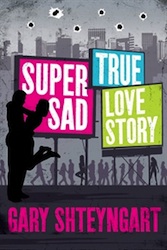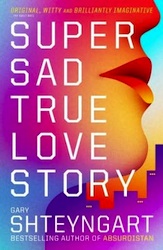Welcome to a special Dystopia Week edition of Genre in the Mainstream! This series highlights mainstream literary writers whose work blends and bends genres in all sorts of fantastic ways. I’m not necessarily saying these writers are writing science fiction or fantasy, but chances are if you like those genres you’ll like these writers too!
And because it’s Dystopia Week, I’m revisiting the extremely popular mainstream literary writer Gary Shteyngart and his super great and relevant dystopia: Super Sad True Love Story.
In my previous review of Super Sad True Love Story, I took great pains to point out the technological aspects that science fictionized this contemporary novel. But, because I have been assimilated into the short-attention span internet generation, I am easily distracted by funny cat videos on YouTube and childish g-chat conversations. As such, I forgot to really mention all the great social commentary inherent in the book and how it creates the subtext of the near-future world the narrative inhabits. The deal with the dystopia of Super Sad True Love Story is simple: if the reader lives in a city, and is at all engaged with popular culture, or has ever been worried about money or their future, then they will find the hyperbolic future projections to be eerily familiar.
Shyteyngart’s dystopia is subtle because he doesn’t present any kind of before and after scenario. To me, most dystopias revolve around an overall extreme decision being made on the part of society at some point before the novel. In 1984, Big Brother was invented before the story begins. In Logan’s Run, it has already been decided that you are to be killed once you turn 22, etc. But Shteyngart doesn’t have anything like that happen, because the big depressing decisions society makes in the novel have already basically been made by our society in real life.
The obvious, hit-you-over the head political way in which this manifests itself is the way the economy is depicted. The United States in this future is entirely reliant upon foreign currency, and the dollar basically doesn’t exist. Your credit score is now broadcast by electronic poles that literally display your number as you walk by. The notion that how one makes their money also defines who they are as a person is also central to most characters’s conversations. Many people either have a job in “Media” or “Retail.” A Media job is naturally more preferable and perceived as cooler, prompting many characters to say something is “SOOO MEDIA” to indicate its coolness.
 This economic theme blends extremely well with Shteyngart’s other dystopian theme, which is more social than political/economic. If you think people you know now are obsessed with their iPhones/Droids and that checking in on FourSquare or having a million Twitter updates is beginning to get excessive, Super Sad True Love Story is basically here to tell you there is absolutely nothing you can do about it. Pretty much every character has a live video blog and is constantly broadcasting their opinions for everyone to absorb. The differences between these character’s video rants and mindless amateurish YouTube videos of today are almost nil. Shteyngart’s main assertion here is that the only thing preventing constant live video blogging from being omnipresent in all areas of life is simply the portability and convenience of the technology. In essence, the most dystopian and dark thing about Super Sad True Love Story isn’t the bleak economic situation, but rather the state of bizarre communication on the internet.
This economic theme blends extremely well with Shteyngart’s other dystopian theme, which is more social than political/economic. If you think people you know now are obsessed with their iPhones/Droids and that checking in on FourSquare or having a million Twitter updates is beginning to get excessive, Super Sad True Love Story is basically here to tell you there is absolutely nothing you can do about it. Pretty much every character has a live video blog and is constantly broadcasting their opinions for everyone to absorb. The differences between these character’s video rants and mindless amateurish YouTube videos of today are almost nil. Shteyngart’s main assertion here is that the only thing preventing constant live video blogging from being omnipresent in all areas of life is simply the portability and convenience of the technology. In essence, the most dystopian and dark thing about Super Sad True Love Story isn’t the bleak economic situation, but rather the state of bizarre communication on the internet.
Everyone in the novel has an account on a network known as Global Teens, a sort of future Facebook, presumably designed for teens, but really designed as a great metaphor by the author to illustrate the childish aspects that instant communication has brought into our discourse. Also, by calling the network Global Teens, Shteyngart does a fairly effective job of reminding us that future technologies are constantly being created by some of the youngest among us.
This leads directly into the third aspect of this particular dystopia. The main character, Lenny, works for Post Human Services, an organization primarily concerned with life extension. There is nothing remotely mystical about this pursuit. Like the life extension process in Robert Heinlein’s Time Enough for Love, this scientific process is presented as matter-of-fact. Ultimately though, the immortality business is depicted as slightly horrific, and the main champion of life extension, Joshie, slowly is cast as a kind of villain of the novel.
 It should come as no surprise that Shteyngart put a negative appraisal on the pursuit of immortality into this novel. As mentioned briefly in my Zardoz essay, Shteyngart has copped to loving Zardoz when he was younger, and as such I’m not shocked he threw his own little dig against immortality into this novel. In this way, you could say that Shteyngart is admitting his own guilt. He is controlled by the media he absorbed when he was younger, just as he is controlled by media now. He uses the internet, just like you and me. We’re all distracted by the pervasiveness of instant communication. (How many times were you distracted by reading this article? And what is this article distracting you from at work or home?) We all want to extend our lives just a little bit past what we’re allowed. And the desire for all of these things will probably create a dystopic world that appears just like ours only in a funhouse mirror.
It should come as no surprise that Shteyngart put a negative appraisal on the pursuit of immortality into this novel. As mentioned briefly in my Zardoz essay, Shteyngart has copped to loving Zardoz when he was younger, and as such I’m not shocked he threw his own little dig against immortality into this novel. In this way, you could say that Shteyngart is admitting his own guilt. He is controlled by the media he absorbed when he was younger, just as he is controlled by media now. He uses the internet, just like you and me. We’re all distracted by the pervasiveness of instant communication. (How many times were you distracted by reading this article? And what is this article distracting you from at work or home?) We all want to extend our lives just a little bit past what we’re allowed. And the desire for all of these things will probably create a dystopic world that appears just like ours only in a funhouse mirror.
Or maybe not. Maybe we’ll be fine. Sorry, but I’ve got to run. There’s a funny cat video I need to watch in which the kitty-cat emerges from a flying stone head and does a Sean Connery voice in LOL speak. KTHKSBAI!
Ryan Britt is a regular blogger for Tor.com. When the super sad future happens, he can be reached via his global teens account: [email protected]










